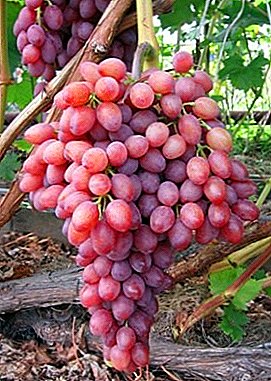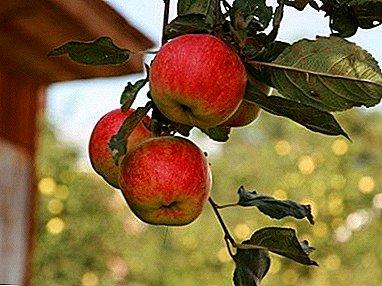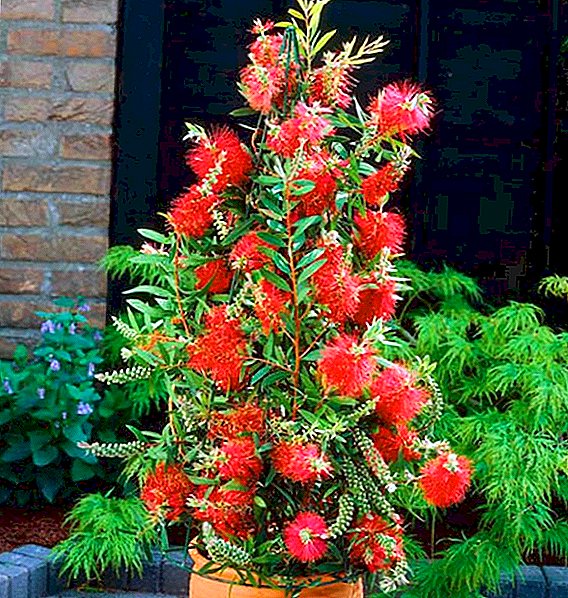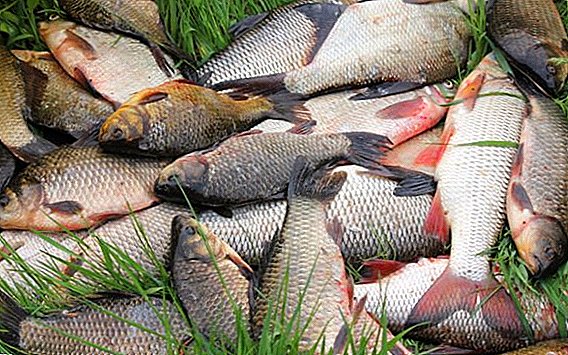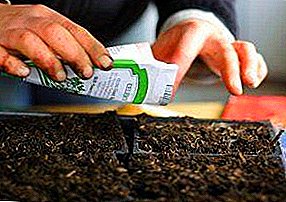
When planting eggplant must take into account several of its features: it is very picky about heat and light.
If the air temperature drops below +20 degrees, the whole process of its vital activity (growth, fruit set) slows down a lot, and sometimes it stops altogether.
Temperature less than +15 degrees leads to fall of color and ovary. The shade of neighboring bushes, trees, too dense planting, prolonged clouds - all this can slow growth, and lead to a decrease in the size of the fruit and even lower yields.
Landing dates
Eggplants are grown through seedlings and directly in the garden, depending on the temperature regime of the region. When planting eggplant seeds it is necessary to take into account that even with the right care, it growth takes a long time. Therefore, most often the plant is planted through seedlings.
 Plant seeds are sown 2 months before direct transplantation into open groundi.e. in February and early March.
Plant seeds are sown 2 months before direct transplantation into open groundi.e. in February and early March.
If you planted eggplants in mid-March, after the shoots appeared, they need to provide additional light with fluorescent lamps up to 80 watts in power before the dive (about a month).
They are hung horizontally at a distance of 50 cm from the seedlings and connected from 8-20 hours, and at night they must be turned off.
Early ripening varieties mature on average after 90 days. Flowering occurs at a temperature not lower than +20 degrees comes after 40 days, and you can harvest the first crop in another 30-32 days.
Preparing for planting seedlings
Landing tanks
Capacity for planting eggplant seedlings any suitable.
Air and moisture pass through the peat base well, which does not allow remaining moisture to remain.
Also for planting eggplant seedlings make good use of plastic cups or special cassettes. Convenience lies in the fact that each seedling is in a separate section and it does not need to dive, it is safe to transfer from the house to the garden, the same conditions are created for each plant.
If there is none of the above, then planted in trays or boxes with a further dive. It should be borne in mind that this operation leads to inevitable damage to the underdeveloped root system and slow growth, as long as the plant does not get sick.
How to prepare the soil for eggplant seedlings?
 In order to prepare the soil for further planting of seedlings, it is necessary before the autumn digging garden to make it into on 1 sq.m. 4 kg of humus and 500 g of superphosphate.
In order to prepare the soil for further planting of seedlings, it is necessary before the autumn digging garden to make it into on 1 sq.m. 4 kg of humus and 500 g of superphosphate.
Add 100 - 150 g of potassium chloride.
It is recommended to land at the past landing site not earlier than two, but preferably three years.
Soil for seedlings with their own hands
Based on one bucket, four parts of peat are mixed, three parts of humus or compost, river sand is used to put one part. When the mixture is ready, 3 matchboxes of superphosphate and a glass of wood ash are added to it (half a cup of potassium sulfate will also work). Then mix the resulting mixture thoroughly.
In order to watering does not wash the soil, from the surface of the soil to the upper edge of the box leave a gap of up to 2 cm.
Preparing eggplant seeds for sowing seedlings
Consider in more detail how to prepare the seeds for planting eggplant seedlings?
Before planting seeds pretreatment is requiredto enhance germination. First you need to carry out the procedure of disinfecting seeds. It is carried out using a solution of manganese-acid potassium for 25 minutes.
Then the seeds are washed with clean water and laid out in fabric pockets in a bowl with a nutrient solution for one day. It includes: 1 liter of water, heated to 25-28 degrees, 1 tsp. nitrofoski (if not, then you can replace the nitrophore with wood ash or liquid sodium humate as well).
This procedure helps the rapid germination of seeds and the rapid emergence of early harvest in the future.
 When the seed pockets undergo the soaking procedure in the nutrient solution, they need to be removed and slightly sprayed with water. Then for 1-2 days at a temperature of 30 degrees before the germination of seeds to shift on a plate.
When the seed pockets undergo the soaking procedure in the nutrient solution, they need to be removed and slightly sprayed with water. Then for 1-2 days at a temperature of 30 degrees before the germination of seeds to shift on a plate.
Bags must be kept moist. In the case when eggplant seeds are planted on seedlings already germinated, then shoots can be expected already on the 5th or 6th day.
Seeds if necessary can be hardened. To do this, they need after the nutrient solution to shift to the bottom shelf of the refrigerator (2-5 degrees) for 2 days, then for 1 day to place in a warm place (18 degrees), then move again to the refrigerator for 2 days.
If the preparation of eggplant seeds for planting on seedlings was successful, then the chances of getting a good harvest increase significantly.
Dive
Eggplant seedlings can be grown with or without a dive. Eggplant seedlings heavily transfers pick, as the root system is very delicate and poorly restored. But if there is a need for a future dive, for example, there are no additional pots for individual planting, then some rules must be followed.
While the seedlings are at the growth stage, its watered a little fertilizer at the root instead of water.
With a dive of seedlings, the dishes for planting are filled with 7 cm of soil mixture, then leveled and compacted a little. Furrows are made at a distance of 5-6 cm from each other by 1-1.5 cm in depth, they are shed with water, then seeds are placed in them at a distance of 2 cm from each other.
 Next, the grooves fall asleep and slightly compacted. Top crops covered with glass or film to preserve moisture and temperature (on average, 20-26 degrees). Sprouts will appear on the 6-10 day.
Next, the grooves fall asleep and slightly compacted. Top crops covered with glass or film to preserve moisture and temperature (on average, 20-26 degrees). Sprouts will appear on the 6-10 day.
After sprouting germs, glass or film must be removed and the air temperature in the room should be reduced. During the day during the week support is on average +17 degrees, and at night +14 degrees.
Then the temperature is raised during the day to +27 degrees, and at night to +14 degrees. This climate is favorable for the development of roots and prepares seedlings for the outdoor climate. Hardening will help the plant to experience less stress and easier to settle down.
Watering, dressing and lighting
The first ten days you need to do watering no more than once a week, frequent watering it will weaken. Water is preferably heated to 25-28 degrees. If possible, before the first shoots, use a sprayer so as not to wash the seeds and not bare the roots.
Required avoid watering leaves on wateringIt causes fungal diseases. Shoots for prevention need to pour a pink solution of potassium permanganate. In the future, eggplant seedlings need to be watered more often as the topsoil dries.
Lack of moisture leads to early lignification of the stem and a decrease in yield. Peat pots are best placed in coasters that need to be replenished periodically with water as it evaporates.
Important! It is necessary to ensure that water does not stagnate - root rot is possible. Water is better to use separated or rainwater.
The first feeding is carried out on the 7-10 day after germination, and in the case of a dive - 10-12 days after this procedure. Fertilizers must contain phosphorus to form the root system. Then fertilize the seedlings no more than 7-10 days to stimulate the plant during the growing season. Fertilize necessary with watering.
 So that the seedlings grow well, do not overly stretch and do not weaken, she extra light needed. You can use phytolamps or luminescent. It should be switched on from 8–20 pm at a distance of 50 cm.
So that the seedlings grow well, do not overly stretch and do not weaken, she extra light needed. You can use phytolamps or luminescent. It should be switched on from 8–20 pm at a distance of 50 cm.
To seedlings eggplant in the future could enjoy the crop, alternate watering with fertilizer, once a month, sprinkle with wood ash. Water in the morning, give hardening seedlings.
Planting seedlings on the street is more favorable in May or early June - this directly depends on the planting of seeds. Understand that it is ready when you have about 12 real sheets formed on it. It is planted in the garden with a nutritious clot of earth from the pot.
If done correctly, then 3 months after the emergence of seedlings, the seedlings are ready for planting in open ground.
Useful materials
Read other articles about growing and caring for eggplant seedlings:
- Different methods of cultivation: in peat tablets, in a snail and even on toilet paper.
- All features of sowing according to the lunar calendar.
- Golden rules for growing from seed.
- Features of cultivation in different regions of Russia: in the Urals, in Siberia and the Moscow region.


